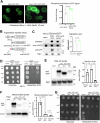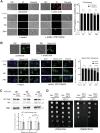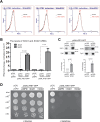Arginyltransferase1 drives a mitochondria-dependent program to induce cell death
- PMID: 40818972
- PMCID: PMC12357888
- DOI: 10.1038/s41419-025-07917-1
Arginyltransferase1 drives a mitochondria-dependent program to induce cell death
Abstract
Cell death regulation is essential for stress adaptation and/or signal response. Past studies have shown that eukaryotic cell death is mediated by an evolutionarily conserved enzyme, arginyltransferase1 (Ate1). The downregulation of Ate1, as seen in many types of cancer, prominently increases cellular tolerance to a variety of stress conditions. Conversely, in yeast and mammalian cells, Ate1 is elevated under acute oxidative stress conditions, and this change appears to be essential for triggering cell death. However, studies of Ate1 were conventionally focused on its function in inducing protein degradation via the N-end rule pathway in the cytosol, leading to an incomplete understanding of the role of Ate1 in cell death. Our recent investigation shows that Ate1 dually exists in the cytosol and mitochondria, the latter of which has an established role in cell death initiation. Here, by using budding yeast as a model organism, we found that mitochondrial translocation of Ate1 is promoted by the presence of oxidative stressors, and this process is essential for inducing cell death preferentially through the apoptotic pathway. Also, we found that Ate1-induced cell death is dependent on the formation of the mitochondrial permeability transition pore and at least partly dependent on the action of mitochondria-contained factors, including the apoptosis-inducing factor, but is not directly dependent on mitochondrial electron transport chain activity or reactive oxygen species (ROS) derived from it. Furthermore, our evidence suggests that, contrary to widespread assumptions, the cytosolic protein degradation pathways, including ubiquitin-proteasome, autophagy, or endoplasmic reticulum (ER) stress response, has little or negligible impacts on Ate1-induced cell death in the tested conditions. We conclude that Ate1 controls the mitochondria-dependent cell death pathway.
© 2025. The Author(s).
Conflict of interest statement
Competing interests: The authors declare no competing interests. Ethics approval and consent to participate: This published article contains data derived from the usage of recombinant DNAs. All related methods were performed in accordance with the relevant guidelines and regulations, approved by the Institutional Biosafety Committee with the protocol number IBC #21-062.
Figures










Update of
-
Arginyltransferase1 drives a mitochondria-dependent program to induce cell death.bioRxiv [Preprint]. 2024 Nov 23:2024.11.22.624728. doi: 10.1101/2024.11.22.624728. bioRxiv. 2024. Update in: Cell Death Dis. 2025 Aug 16;16(1):622. doi: 10.1038/s41419-025-07917-1. PMID: 39605427 Free PMC article. Updated. Preprint.
References
-
- Kaji H, Novelli GD, Kaji A. A soluble amino acid-incorporating system from rat liver. Biochim Biophys Acta. 1963;76:474–7. - PubMed
-
- Bachmair A, Finley D, Varshavsky A. In vivo half-life of a protein is a function of its amino-terminal residue. Science. 1986;234:179–86. - PubMed
-
- Chakraborty G, Leach T, Zanakis MF, Ingoglia NA. Posttranslational protein modification by amino acid addition in regenerating optic nerves of goldfish. J Neurochem. 1986;46:726–32. - PubMed
-
- Shyne-Athwal S, Riccio RV, Chakraborty G, Ingoglia NA. Protein modification by amino acid addition is increased in crushed sciatic but not optic nerves. Science. 1986;231:603–5. - PubMed
MeSH terms
Substances
Grants and funding
- R01GM138557/U.S. Department of Health & Human Services | NIH | National Institute of General Medical Sciences (NIGMS)
- DST-SRG/2019/001360/Department of Science and Technology, Ministry of Science and Technology (DST)
- P30 CA240139/CA/NCI NIH HHS/United States
- R01 GM138557/GM/NIGMS NIH HHS/United States
- MoE-STARS/STARS1/385/Ministry of Earth Sciences (MoES)
LinkOut - more resources
Full Text Sources
Miscellaneous

